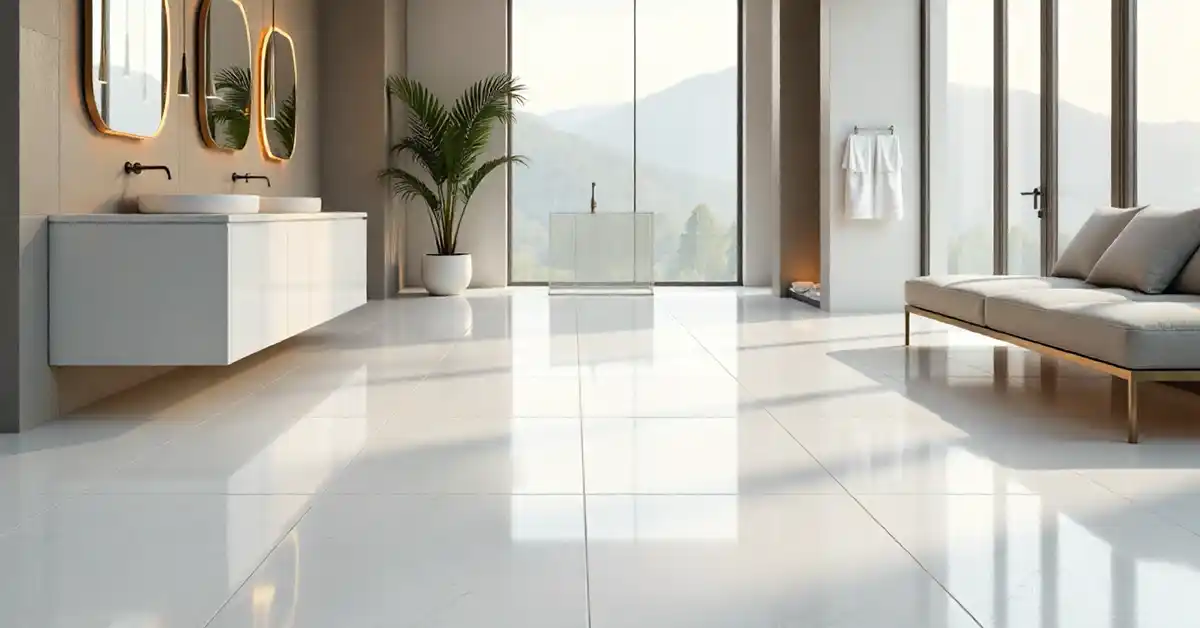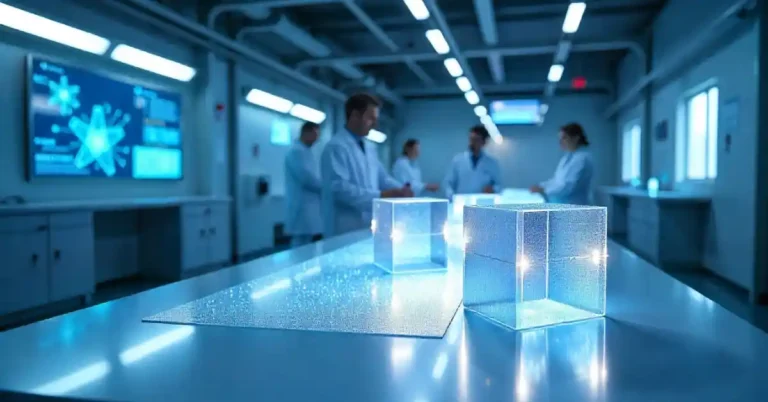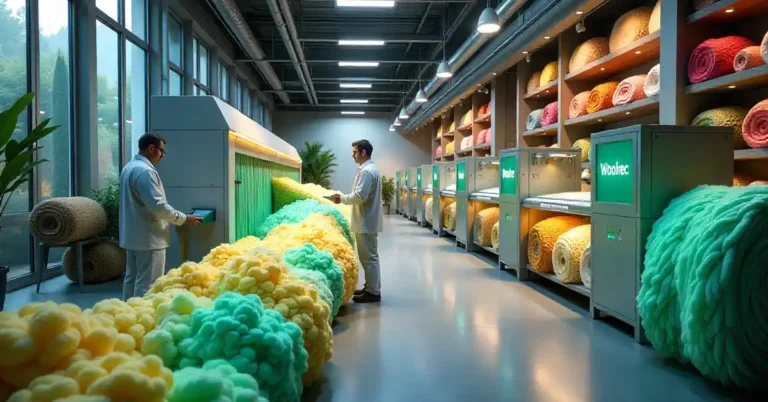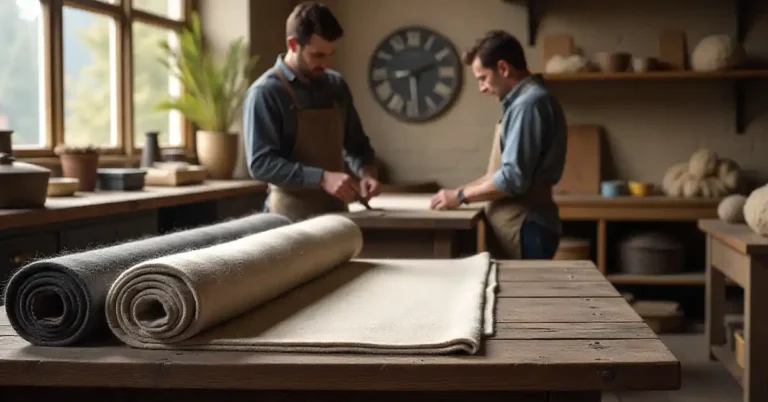Welcome to our complete guide, where we will be exploring the world of Sodiceram. The evolution of ceramic technology has transformed modern interior design, moving beyond simple functionality to become a cornerstone of aesthetic expression and smart home innovation. Among the leaders of this change is Sodiceram, a unique material that redefines what we expect from surfaces.
This comprehensive guide will walk you through everything you need to know about Sodiceram. We will cover its scientific foundation, rich history, diverse product range, and groundbreaking smart features. You will learn why Sodiceram matters in today’s construction and design industry and how it provides unmatched value for homes and businesses.
What makes Sodiceram truly unique is its innovative use of sodium-based compounds, which enhance the material’s properties far beyond those of conventional ceramic tiles. This guide will provide a deep dive into what Sodiceram is, how it’s made, and its extensive benefits. From its robust product lines to its commitment to sustainability, you’ll discover why Sodiceram has become a preferred choice for architects, designers, and homeowners seeking excellence and longevity in their projects.
2. What is Sodiceram?
Sodiceram is an advanced ceramic material engineered with sodium-based compounds to deliver superior performance, durability, and aesthetic versatility. At its core, Sodiceram builds upon the foundational strengths of traditional ceramics and elevates them through a specialized manufacturing process. This process integrates high-purity raw materials with carefully selected sodium additives, resulting in a product that is denser, stronger, and more resistant to wear and environmental stressors.
The engineering behind Sodiceram flooring and tiles involves precise thermal treatments and pressure applications that create a vitrified, non-porous surface. This key feature makes it highly resistant to moisture, stains, and scratches. Unlike traditional ceramics, which can be prone to chipping and water absorption, Sodiceram’s unique composition ensures it maintains its integrity and appearance for decades. The integration of sodium-based compounds is not just an enhancement; it is a fundamental re-imagining of ceramic innovation, setting a new standard for performance in modern surfacing.
2.1 The Science Behind Sodiceram
The exceptional qualities of Sodiceram stem from its unique scientific composition and advanced manufacturing techniques.
- Composition and Materials Used: Sodiceram is created from a precise blend of high-quality clays, feldspar, silica sand, and other natural minerals. The key differentiator is the inclusion of specialized sodium compounds, which act as a powerful fluxing agent during the firing process.
- How Sodium Compounds Enhance Ceramic Properties: When heated to extreme temperatures, these sodium compounds lower the vitrification point of the ceramic mixture. This allows the materials to fuse together into a single, glass-like mass that is incredibly dense and non-porous. This process significantly boosts the tile’s mechanical strength, reduces water absorption to near-zero, and improves its resistance to chemical and thermal shock.
- Advanced Manufacturing Techniques: The production of Sodiceram tiles employs state-of-the-art technology, including high-pressure presses and digitally controlled kilns. This ensures uniformity, precise dimensions, and consistent quality across every tile.
- Quality Standards and Certifications: Sodiceram is manufactured to meet rigorous international quality standards. Each product undergoes stringent testing for durability, slip resistance, and dimensional stability, ensuring it performs reliably in any application.
3. The Rich History and Evolution of Sodiceram
Sodiceram’s story begins in the early 1990s, rooted in a vision to push the boundaries of ceramic technology. What started as a focused, family-influenced enterprise quickly grew into an industry leader by prioritizing innovation and quality. The company’s journey is marked by a relentless pursuit of excellence, evolving from its initial offerings to a diverse portfolio of advanced ceramic solutions.
Key milestones in Sodiceram’s development include the perfection of its unique sodium-based ceramic formula and the early adoption of digital printing technologies, which allowed for unparalleled design flexibility. The company has consistently adapted to changing market trends, embracing sustainability and smart technology to meet the needs of modern consumers. A core element of its success has been the seamless integration of traditional Italian craftsmanship with sophisticated, modern technology, creating products that are both timeless and forward-thinking.
3.1 The Italian Heritage and Location
Sodiceram’s identity is deeply connected to its Italian heritage. Situated in Italy’s renowned ceramic heartland, the company benefits from a location that is rich in both history and resources.
- Strategic Location in Italy’s Ceramic Heartland: Being located in this specialized region provides a unique competitive advantage, fostering an environment of innovation and high standards.
- Access to Premium Raw Materials: The area offers access to some of the world’s finest clays and minerals, which are essential for creating high-quality sodium-based ceramics.
- Influence of Italian Design Tradition: Sodiceram is heavily influenced by Italy’s legacy of superior design and aesthetic sensibility. This tradition is reflected in the elegance, style, and sophistication of its product collections.
- Global Reach from Italian Roots: While proudly Italian, Sodiceram has a global outlook. From its home base, the company exports its premium ceramic tiles to markets around the world, sharing its heritage of quality and design with an international audience.
4. Comprehensive Product Range
Sodiceram offers a vast and versatile product range designed to meet the functional and aesthetic needs of any project, from residential renovations to large-scale commercial developments.
4.1 Types of Sodiceram Tiles
Floor Tiles
Sodiceram flooring is engineered for performance and beauty.
- Residential Applications: Perfect for kitchens, bathrooms, and living areas, offering a blend of elegance and durability that stands up to daily life.
- Commercial-Grade Options: Designed for retail, hospitality, and office environments, these tiles provide superior wear resistance and easy maintenance.
- High-Traffic Solutions: For areas like airports, shopping malls, and public buildings, Sodiceram offers robust tiles that maintain their appearance under constant use.
Wall Tiles
Transform vertical surfaces into stunning features with Sodiceram wall tiles.
- Interior Wall Solutions: Lightweight and easy to install, these tiles are ideal for creating feature walls or stylish backsplashes.
- Decorative Accent Pieces: Available in intricate patterns and textures, these tiles add a touch of artistry to any room.
- Bathroom and Kitchen Specialties: With excellent water resistance and cleanability, they are a practical and beautiful choice for wet areas.
Outdoor Tiles
Engineered to withstand the elements, Sodiceram outdoor tiles combine performance with style.
- Weather-Resistant Options: These tiles resist fading from UV exposure, damage from frost, and staining from environmental pollutants.
- Patio and Walkway Solutions: With high slip resistance, they provide a safe and attractive surface for outdoor living spaces.
- Durability in Extreme Conditions: The dense, non-porous body prevents cracking and damage in freeze-thaw cycles.
4.2 Specialized Ceramic Products
Beyond standard tiles, Sodiceram offers specialized ceramics for unique applications.
- Porcelain Variants: Offering enhanced strength and near-zero water absorption, these are perfect for the most demanding environments.
- Stoneware: Known for its exceptional thermal shock resistance, making it suitable for areas with rapid temperature changes.
- Earthenware: Provides vibrant color options and is often used for decorative wall applications where high durability is not the primary concern.
- High-Performance Ceramics: Developed for specialized industrial applications requiring specific properties like electrical insulation or extreme heat resistance.
4.3 Finish Options
The right finish can dramatically alter the look and feel of a space.
Glazed Tiles
- Color Depth Enhancement: A liquid glass coating is fused to the tile, creating rich, vibrant colors.
- Stain Resistance Properties: The non-porous glaze creates a protective layer that is impervious to stains and easy to clean.
- Ideal Applications: Best for wall tiles, kitchen backsplashes, and residential bathroom floors.
Polished Tiles
- Reflective Luxury Surfaces: The tile surface is polished to a high gloss, creating a sophisticated, mirror-like finish.
- Commercial Space Suitability: Often used in hotel lobbies, luxury retail, and corporate offices to create an impression of elegance.
- Maintenance Requirements: Requires regular cleaning to maintain its shine and can be slippery when wet.
Matte Finish Tiles
- Non-Reflective Elegance: Offers a soft, natural look that minimizes glare and hides smudges or water spots.
- Slip-Resistance Benefits: The textured surface provides better grip, making it a safer choice for floors in both residential and commercial settings.
- High-Traffic Area Advantages: Its durability and ability to conceal minor wear make it ideal for busy areas.
5. Innovative Design Styles and Aesthetics
Sodiceram excels in offering a wide spectrum of design styles to suit any architectural vision. The collections are crafted to provide architects and designers with the ultimate creative freedom, enabling them to build unique and inspiring spaces. From understated elegance to bold statements, the aesthetic versatility of Sodiceram is one of its greatest strengths.
The product lineup includes:
- Contemporary Minimalist Designs: Clean lines, neutral color palettes, and subtle textures that create a sense of calm and sophistication.
- Classic and Traditional Patterns: Timeless designs inspired by natural stone like marble and travertine, as well as historic motifs.
- Bold Colors and Intricate Patterns: For those looking to make a statement, Sodiceram offers vibrant hues and complex geometric or artistic patterns.
- Rustic Charm Collections: Tiles that mimic the look of aged wood, terracotta, or natural slate, bringing warmth and character to a space.
- Ultra-Modern Sophistication: Large-format tiles with metallic effects or concrete-inspired finishes for a sleek, industrial aesthetic.
- Customization Capabilities: Sodiceram provides options for custom designs, allowing for completely personalized spaces that reflect a unique brand or individual style.
5.1 The 2025 Design Collection
The 2025 Design Collection showcases the future of ceramic surfaces. This latest lineup introduces cutting-edge textures that engage the senses, from soft, fabric-like finishes to rough, geological-inspired surfaces. The collection emphasizes trend-forward aesthetics, featuring earthy tones, muted pastels, and deep, dramatic shades. A key highlight is the expanded integration of smart ceramics, with new features designed to enhance comfort and convenience in modern living.
6. Smart Ceramics Technology
Sodiceram is at the forefront of integrating technology into surfacing materials with its range of smart ceramics. This innovation transforms passive surfaces into active, responsive elements within a home or commercial space. Smart ceramics blend traditional craftsmanship with modern tech, creating environments that are more comfortable, efficient, and attuned to the needs of their occupants.
6.1 Intelligent Features and Functions
Sodiceram’s smart tiles are embedded with advanced technology to offer a range of intelligent capabilities:
- Temperature Regulation: Embedded sensors can work with underfloor heating systems to maintain optimal room temperatures efficiently.
- Customizable Lighting Integration: Certain tiles can incorporate LED lighting, allowing for customizable mood-enhancing effects or functional pathway lighting.
- Humidity Tracking: Sensors within the tiles can monitor humidity levels, making them ideal for bathrooms and spas to help manage ventilation.
- Water-Resistant Technology: The inherent water resistance of Sodiceram is enhanced in smart versions, ensuring the protection of all embedded electronic components.
6.2 How Smart Technology Transforms Home Décor
The practical benefits of Sodiceram’s smart technology are significant. Imagine a bathroom floor that warms automatically on a cold morning or a hallway that lights up softly as you walk through it at night. These features move beyond novelty to provide real enhancements to daily life. This technology contributes to energy efficiency by optimizing heating and lighting usage. Furthermore, these smart ceramics can integrate seamlessly with existing smart home systems, allowing users to control their environment with a simple voice command or tap on their smartphone.
7. Key Benefits and Features
Choosing Sodiceram for your project offers a multitude of advantages that combine long-term performance with exceptional design.
7.1 Durability and Longevity
Sodiceram is engineered to last. Its high-density structure provides outstanding resistance to scratches, stains, and impacts. The tiles can withstand heavy foot traffic without showing signs of wear, making them a perfect choice for both busy homes and demanding commercial environments. With proper installation and care, Sodiceram flooring has an expected lifespan of 20-30 years or more, and its advanced crack prevention technology ensures it remains intact even under stress.
7.2 Aesthetic Advantages
With Sodiceram, you never have to compromise on style. The brand offers an extensive variety of designs, colors, textures, and finishes, from hyper-realistic natural stone and wood looks to bold, contemporary patterns. This versatility allows Sodiceram to complement any interior style, whether minimalist, traditional, or industrial. The premium look and feel of these sodium-based ceramics add a touch of elegance and value to any property.
7.3 Low Maintenance Requirements
One of the most practical benefits of Sodiceram is how easy it is to maintain. The non-porous surface resists stains and moisture, so spills can be wiped away without a trace.
- Easy Cleaning Protocols: Daily maintenance is as simple as sweeping or vacuuming to remove loose debris, followed by mopping with a pH-neutral cleaner.
- Moisture and Stain Resistance: Its near-zero porosity means liquids and dirt remain on the surface, preventing discoloration.
- Long-Term Care: No special sealants or waxes are required to maintain its appearance, saving time and money over the long run.
7.4 Cost-Effectiveness Over Time
While the initial investment for Sodiceram may be higher than some alternatives, its long-term value is exceptional. Its durability means you will save significantly on repairs and replacements over the decades. Some smart ceramic options can also contribute to energy efficiency, leading to lower utility bills. When you consider its long lifespan and low maintenance costs, Sodiceram delivers an excellent return on investment.
7.5 Water and Moisture Resistance
Sodiceram’s extremely low water absorption rate (typically below 0.5%) makes it an ideal material for wet areas. It is perfectly suited for bathrooms, kitchens, laundry rooms, and basements. This high level of humidity tolerance prevents the growth of mold and mildew, contributing to a healthier indoor environment. Its performance in wet applications ensures that your surfaces remain beautiful and hygienic for years.
8. Sustainability and Environmental Commitment
Sodiceram is committed to responsible manufacturing and environmental stewardship. The brand integrates sustainable practices throughout its production process, from sourcing raw materials to creating recyclable products.
8.1 Eco-Friendly Materials and Practices
The foundation of Sodiceram is natural and sustainable.
- Sustainable Sourcing of Raw Materials: The company prioritizes sourcing clay, sand, and other minerals from responsible suppliers who adhere to environmental guidelines.
- Recyclable Material Integration: A significant percentage of pre-consumer recycled material is incorporated into the production of new tiles, reducing waste and conserving natural resources.
- Reduced Environmental Footprint: The entire lifecycle of the product is designed to minimize its impact on the environment.
- Natural Material Composition: Sodiceram is free from volatile organic compounds (VOCs), contributing to better indoor air quality.
8.2 Energy-Efficient Production
Sodiceram leverages modern technology to make its manufacturing processes as green as possible.
- Modern Manufacturing Technology: State-of-the-art kilns and machinery are used to optimize energy use and reduce consumption.
- Reduced Energy Consumption: The company continuously invests in technologies like heat recovery systems that capture and reuse waste heat from kilns.
- Carbon Footprint Minimization: Through efficient logistics and production, Sodiceram actively works to lower its carbon footprint.
- Green Manufacturing: The processes are aligned with principles of green manufacturing, aiming to reduce pollution and waste at every stage.
8.3 End-of-Life Recyclability
Sodiceram is designed with a circular economy in mind. Because it is made from natural materials, it is 100% recyclable at the end of its long life. Old tiles can be crushed and used as aggregate for road construction or as raw material in the production of new ceramic products. This commitment to recyclability significantly reduces landfill impact and promotes a more sustainable construction industry.
9. Installation Guide for Sodiceram Flooring
Proper installation is key to ensuring the longevity and performance of your Sodiceram flooring. While professional installation is recommended for the best results, experienced DIYers can also achieve a great finish by following these steps.
9.1 Pre-Installation Preparation
Preparation is the most critical step.
- Surface Preparation: The subfloor must be clean, dry, and free of debris, grease, or wax. Any existing flooring should be removed.
- Ensuring a Level Substrate: The surface must be perfectly level. Use a self-leveling compound to fill any dips or grind down high spots. An uneven subfloor can lead to cracked tiles.
- Tools and Materials Needed: Gather all necessary tools: a tile saw or cutter, notched trowel, level, tile spacers, rubber mallet, grout float, and sponges. You will also need tile adhesive (mortar) and grout.
- Professional vs. DIY Considerations: Large-format tiles or complex patterns are best left to professionals. If you are new to tiling, consider starting with a small, simple area.
9.2 Tile Laying Process
With the surface prepared, you can begin laying the tiles.
- Adhesive and Mortar Application: Mix the adhesive according to the manufacturer’s instructions. Apply it to a small section of the floor using the notched side of the trowel.
- Proper Tile Placement: Press each tile into the adhesive with a slight twisting motion to ensure full contact. Use a rubber mallet to gently tap it into place.
- Spacing and Alignment: Use tile spacers to maintain consistent grout lines. Regularly check that your lines are straight and the tiles are level.
- Avoiding Common Errors: Only mix as much adhesive as you can use within its working time. Clean any excess adhesive from the tile surface before it dries.
9.3 Grouting and Finishing Touches
Grouting protects the tiles and completes the look.
- Grout Selection and Application: Choose a grout color that complements your tiles. After the adhesive has fully cured (typically 24-48 hours), apply the grout with a grout float, pressing it firmly into the joints.
- Sealing for Moisture Protection: While Sodiceram tiles are non-porous, grout lines can be susceptible to moisture and staining. Using a grout sealer in wet areas is highly recommended.
- Final Cleaning and Polishing: Once the grout has set, use a damp sponge to wipe the excess from the tile surface. A haze may form, which can be buffed off with a dry cloth after the grout has fully cured.
- Curing Time: Allow the grout to cure completely as per the manufacturer’s guidelines before allowing heavy foot traffic or placing furniture.
10. Maintenance Tips and Best Practices
Maintaining the beauty of your Sodiceram tiles is simple with the right care routine.
- Daily Cleaning: Sweep with a soft-bristle broom or vacuum with a hard floor attachment to remove dust and grit that can be abrasive.
- Proper Mopping: Clean the floor with a damp mop using warm water and a small amount of a pH-neutral, non-abrasive cleaner. This prevents soap scum buildup and protects the tile’s finish.
- Spill Management: Clean up spills promptly, especially acidic substances like wine, juice, or coffee, to prevent any potential for staining the grout.
- Cleaning Products to Avoid: Never use harsh chemicals like bleach, ammonia, or acid-based cleaners. Avoid abrasive scouring powders and steel wool, as they can scratch the surface.
- Periodic Inspection: Occasionally check for any cracked tiles or damaged grout and repair them promptly to prevent moisture from seeping underneath.
- Preventing Scratches: Use felt pads on the bottom of furniture legs and avoid dragging heavy objects across the floor.
- Professional Maintenance: For commercial spaces or deep cleaning, consider hiring a professional tile and grout cleaning service every few years.
11. Industry Applications and Use Cases
The unique properties of Sodiceram make it a versatile material suitable for a wide array of applications across different industries.
11.1 Residential Applications
- Kitchens: Its resistance to stains, heat, and moisture makes Sodiceram flooring and backsplashes a perfect choice for busy kitchens.
- Bathrooms: The near-zero water absorption rate prevents water damage and mold growth, making it ideal for bathroom floors and shower walls.
- Living Rooms and Hallways: The durability and extensive design options allow for beautiful, long-lasting floors that can handle high foot traffic.
- Outdoor Patios and Walkways: Frost-proof and slip-resistant varieties provide a safe and stylish solution for outdoor spaces.
11.2 Commercial and Industrial Uses
- Restaurants and Cafés: Sodiceram is easy to clean and can withstand constant foot traffic, spills, and heavy furniture, making it perfect for the hospitality industry.
- Boutique Hotels: The luxurious finishes and smart ceramic options help create a memorable and upscale guest experience.
- Retail Stores and Showrooms: Its durability and aesthetic appeal make it a great choice for creating inviting and resilient commercial floors.
- Office Buildings: Provides a professional look that is easy to maintain in high-traffic corporate environments.
- Healthcare Facilities: Because it is hygienic and easy to sterilize, Sodiceram is used in hospitals and clinics. Its biocompatibility makes it suitable for certain medical equipment components.
11.3 Specialized Sectors
The advanced properties of sodium-based ceramics also lend themselves to highly specialized fields.
- Automotive Industry: Used for components that require high wear resistance and thermal stability.
- Electronics Industry: Its excellent electrical insulation properties make it a valuable material for insulators and substrates in electronic devices.
- Aerospace: Certain high-performance grades are used for components that need to withstand extreme temperatures and mechanical stress.
- Art World: Artists and sculptors use specialized ceramic formulations for their durability and unique finishes.
12. Sodiceram vs. Other Flooring Options
How does Sodiceram stack up against other popular flooring materials? Here’s a helpful comparison.
12.1 Sodiceram vs. Traditional Ceramic Tiles
- Moisture Resistance: Sodiceram has a much lower water absorption rate, making it far superior for wet areas.
- Durability: The dense, vitrified body of Sodiceram makes it stronger and more resistant to chipping and cracking than traditional ceramic tiles.
- Design Versatility: While both offer design options, Sodiceram’s advanced printing technology often produces more realistic and intricate patterns.
- Cost: Sodiceram typically has a higher upfront cost, but its longevity and low maintenance offer better long-term value.
12.2 Sodiceram vs. Vinyl Flooring
- Initial Cost: Luxury vinyl tile (LVT) is often cheaper upfront.
- Installation: LVT can be easier to install for DIYers.
- Longevity and Appearance: Sodiceram offers a more premium, authentic look and feel and has a significantly longer lifespan than vinyl, which can scratch, dent, and fade over time.
- Maintenance: Both are low-maintenance, but Sodiceram is more resistant to deep scratches and heat damage.
12.3 Sodiceram vs. Hardwood Flooring
- Durability and Moisture: Hardwood is susceptible to scratches, dents, and water damage, whereas Sodiceram is highly resistant to all three.
- Maintenance: Hardwood requires periodic refinishing and careful cleaning, while Sodiceram needs only simple mopping.
- Aesthetics: Hardwood offers natural warmth, but Sodiceram provides hyper-realistic wood-look tiles that combine the aesthetic of wood with the performance of ceramic.
- Cost: The cost can be comparable, but Sodiceram’s long-term maintenance costs are much lower.
12.4 Sodiceram vs. Other Ceramic Alternatives
Compared to other advanced ceramic products like standard porcelain, Sodiceram often differentiates itself through its specific sodium-based formulation. This can lead to enhanced performance benchmarks in areas like thermal shock resistance or mechanical strength. The brand’s focus on integrated smart ceramics and cutting-edge Italian design also provides a unique value proposition that sets it apart from other high-end ceramic options.
13. Real-World Success Stories
Designers and homeowners consistently choose Sodiceram to transform spaces. Here are a few illustrative examples:
- Residential Kitchen Transformation: A family renovated their outdated kitchen with large-format, marble-look Sodiceram flooring. The polished finish brightened the space, and the homeowners praised its incredible stain resistance and ease of cleaning, especially with young children.
- Boutique Hotel Lobby: An architect selected a metallic-finish Sodiceram for the lobby of a new boutique hotel. The large tiles created a seamless, high-end look that has withstood heavy luggage and constant foot traffic while maintaining its sophisticated appearance. The hotel manager noted that the floor still looks brand new after two years of operation.
- Modern Bathroom Renovation: An interior designer used matte-finish, concrete-look Sodiceram tiles for the floors and walls of a master bathroom to achieve a minimalist, spa-like feel. The client loved the non-slip texture and the fact that the surface resists water spots and is exceptionally easy to keep clean. The integrated smart floor heating was highlighted as a favorite feature.
- Outdoor Patio Project: A homeowner in a cold climate replaced a cracked concrete patio with frost-proof Sodiceram outdoor pavers. The tiles have endured multiple freeze-thaw cycles without any damage, and the family enjoys the stylish, wood-look finish that connects their indoor and outdoor living spaces.
14. Collaborations with Designers and Architects
Sodiceram actively partners with leading architects and interior designers to push the boundaries of ceramic design. These collaborations are a cornerstone of the brand’s innovation strategy, resulting in co-created collections and special editions that reflect the latest trends in architecture and design.
Professionals are drawn to Sodiceram for the creative flexibility it offers. The extensive range of sizes, finishes, and custom capabilities allows them to realize their most ambitious visions, creating personalized spaces and powerful visual narratives. By working closely with the design community, Sodiceram ensures its products are not only technologically advanced but also aesthetically relevant and inspiring. These partnerships help drive innovation, leading to new textures, patterns, and applications that shape the future of interior surfaces.
15. Common Mistakes to Avoid
To ensure your Sodiceram installation is successful and long-lasting, avoid these common pitfalls:
- Skipping Proper Surface Preparation: The single biggest mistake is failing to ensure the subfloor is perfectly clean, level, and dry. This can lead to lippage (uneven tiles) and cracking.
- Using Harsh Chemical Cleaners: Abrasive or acidic cleaners can damage the grout and dull the finish of the tile over time.
- Ignoring Manufacturer Guidelines: Always follow the specific installation and curing instructions for the adhesive and grout you are using.
- DIY Without Proper Expertise: Attempting a complex installation, such as with large-format tiles or intricate patterns, without experience can lead to costly errors.
- Inadequate Grout Sealing: In wet areas, failing to seal the grout can lead to staining and mold growth.
- Dragging Heavy Furniture: Always lift, never drag, heavy items across the floor to prevent scratches.
- Neglecting Periodic Inspections: Small cracks in grout can allow moisture to penetrate, so it’s important to inspect and repair them early.
- Improper Adhesive Selection: Using the wrong type of mortar for the tile size or substrate can result in bonding failure.
16. Future Innovations and Trends
Sodiceram is continuously exploring the future of ceramic technology. The brand is dedicated to pioneering new materials and integrating smarter, more sustainable solutions.
16.1 Upcoming Product Developments
- New Material Formulations: Research and development are focused on creating new sodium-based ceramic formulations that are even lighter, stronger, and more versatile.
- Lightweight Yet Durable Solutions: Innovations in thin-tile technology will make installation easier and reduce the structural load on buildings.
- 3D Printing Applications: Sodiceram is exploring the use of 3D printing to create highly customized and intricate ceramic pieces for bespoke projects.
16.2 Technology Integration
- Advanced Smart Ceramic Features: The next generation of smart ceramics will include features like air quality monitoring and self-cleaning surfaces.
- IoT and Home Automation: Deeper integration with the Internet of Things (IoT) will allow Sodiceram surfaces to communicate seamlessly with other smart home devices.
- Sustainable Building Innovations: The company is working on developing tiles that can contribute to a building’s energy efficiency, for example, by improving thermal insulation.
16.3 Market Expansion Plans
Sodiceram aims to make its innovative products accessible globally. This includes expanding its network of distributors, forging new industry partnerships, and engaging with design communities in emerging markets to share its vision for the future of surfaces.
17. Advantages and Limitations of Sodiceram
Like any advanced material, Sodiceram has a distinct set of advantages and potential limitations to consider.
17.1 Key Advantages
- Superior Durability: Highly resistant to scratches, stains, and wear.
- Improved Thermal Properties: Offers good thermal insulation and can withstand thermal shock.
- Enhanced Electrical Resistance: An excellent insulator, making it useful for specialized electronic applications.
- Biocompatibility: Non-toxic and hygienic, making it suitable for healthcare settings.
- Aesthetic and Functional Versatility: An enormous range of styles and high performance across many applications.
17.2 Potential Limitations
- Complex Production: The advanced manufacturing process is more complex than that of traditional ceramics.
- Higher Initial Cost: The initial investment can be higher than for other flooring options.
- Specific Handling Requirements: Large-format or specialized tiles may require expert handling and installation.
- Hardness: While a benefit for durability, the hard surface can be less forgiving if items are dropped and may feel cold underfoot without underfloor heating.
- Learning Curve for Installation: Proper installation is crucial and may require professional expertise.
18. Pricing and Cost Considerations
The price of Sodiceram can vary significantly based on several factors:
- Product Line: Entry-level collections will be more affordable than premium designer or smart ceramic lines.
- Tile Size and Finish: Large-format tiles and specialized finishes like polished or textured surfaces typically cost more.
- Complexity of Design: Intricate patterns or custom-printed tiles will also affect the price.
As a general estimate, you can expect the cost per square foot for Sodiceram to be in the mid-to-high range for ceramic tiles, reflecting its premium quality and performance. Installation costs will also vary based on your location and the complexity of the job.
While the upfront cost is a consideration, it’s important to factor in the long-term value. With its exceptional durability and low maintenance needs, Sodiceram often proves to be a more cost-effective choice over its lifespan compared to materials that require frequent replacement or refinishing. For accurate pricing, it is always best to request a quote from an official distributor.
19. Where to Buy Sodiceram Products
You can purchase Sodiceram products through a network of authorized channels to ensure you receive genuine, high-quality material.
- Official Distributors and Retailers: Sodiceram has a network of approved partners around the world. Visit the company’s official website to find a distributor near you.
- Online Purchasing Options: Select collections may be available for purchase through authorized online retailers.
- Showroom Locations: Visiting a showroom is the best way to see and feel the quality of Sodiceram tiles firsthand. You can view large samples and get expert advice.
- Working with Contractors and Designers: Many professionals have relationships with Sodiceram suppliers and can manage the procurement process for your project.
- International Availability: Sodiceram has a growing global presence. Check with your regional distributor for availability and shipping options.
- Requesting Quotes and Samples: Contact a local retailer or distributor to request samples and get a detailed quote for your project.
20. Legal, Corporate Governance, and Quality Standards
Sodiceram operates with a strong commitment to regulatory compliance, quality assurance, and corporate transparency. The company adheres to all relevant industry standards for ceramic tile manufacturing, including those for performance, safety, and environmental impact.
Rigorous quality assurance processes are in place at every stage of production, from raw material inspection to final product testing. This ensures that every tile that leaves the factory meets the brand’s high standards of excellence. Sodiceram is also committed to ethical business practices, stakeholder engagement, and clear consumer protection policies, including comprehensive warranty and guarantee information for its products.
21. FAQs About Sodiceram
Q1: What is Sodiceram flooring made of?
Sodiceram is made from a blend of natural materials, including high-quality clays, sand, and feldspar, enhanced with specialized sodium-based compounds that give it superior density and strength.
Q2: How long does Sodiceram flooring last?
With proper installation and care, Sodiceram flooring can easily last 20-30 years or even longer, making it a highly durable, long-term investment.
Q3: Is Sodiceram easy to maintain?
Yes, it is very low-maintenance. Its non-porous surface resists stains and is easy to clean with simple sweeping and mopping with a pH-neutral cleaner.
Q4: Can Sodiceram be used in bathrooms and kitchens?
Absolutely. Its extremely low water absorption rate makes it one of the best materials for wet areas like bathrooms and kitchens, as it resists moisture and prevents mold growth.
Q5: How does Sodiceram compare to ceramic or wood flooring?
Sodiceram is significantly more durable and water-resistant than both traditional ceramic and hardwood flooring. It offers the aesthetic of natural materials like wood with far superior performance and lower maintenance.
Q6: Can I install Sodiceram flooring myself?
While an experienced DIYer can install Sodiceram, professional installation is recommended, especially for large-format tiles or complex patterns, to ensure a perfect finish and long-term durability.
Q7: Is Sodiceram flooring eco-friendly?
Yes. It is made from natural, abundant raw materials, often contains recycled content, is manufactured using energy-efficient processes, and is 100% recyclable at the end of its life.
Q8: What makes Sodiceram different from traditional ceramics?
The key difference is the use of sodium compounds in its formulation, which creates a denser, stronger, and less porous tile than traditional ceramics.
Q9: Does Sodiceram offer smart ceramic features?
Yes, Sodiceram offers smart ceramics with integrated features like temperature regulation, customizable LED lighting, and humidity sensors.
Q10: What industries benefit most from Sodiceram products?
Residential (kitchens, baths), commercial (hotels, retail), and specialized sectors like healthcare and electronics all benefit from its durability, hygiene, and performance characteristics.
Q11: How do I clean Sodiceram tiles?
Sweep or vacuum regularly and mop with warm water and a small amount of a pH-neutral cleaner. Avoid harsh chemicals, bleach, and abrasive scrubbers.
Q12: What design styles are available?
Sodiceram offers a vast range of styles, including minimalist contemporary designs, classic stone and wood looks, bold patterns, and rustic textures to suit any aesthetic preference.







